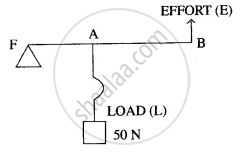Advertisements
Advertisements
प्रश्न
A 4 m long rod of negligible weight is to be balanced about a point 125 cm from one end and a load of 18 kgf is suspended at a point 60 cm from the support on the shorter arm.
- If a weight W is placed at a distance of 250 cm from the support on the longer arm to balance the rod, find W.
- If a weight 5 kgf is kept to balance the rod, find its position.
- To which class of lever does it belong?
उत्तर
(a) W × CE = 18 × DC
W × 250 = 18 × 60

∴ W = `(18 xx 60)/250`
∴ W = 4.32 kgf
(b) New W = 5 kgf
Let it be placed at a distance x from C on arm CB
∴ 5 × x = 18 × 60
∴ x = `(18 xx 60)/5`
= 216 cm = 2.16 m
(c) It belongs to class I lever.
APPEARS IN
संबंधित प्रश्न
Give one example of a class I lever where mechanical advantage is more than one ?
The following belong to which class of lever?
Rowing of a boat
The following belong to which class of lever?
A fire tongs
The following belong to which class of lever?
Knife
The following belong to which class of lever?
Fore-arm
Shears, used for cutting metals and scissors used for cutting clothes are both examples of levers of the first order. However, whereas the shears always have short blades and long handles, the scissors often have blades much longer than the handles. Explain, why this is so?
The following are an example of levers. State the class of lever to which each one belongs giving the relative positions of Load (L), Effort (E), Fulcrum (F):
(i) Scissors (ii) Sugar tongs (iii) Nutcracker (iv) Pliers.
Draw a labelled sketch of a second class lever. Give one example of such a lever.
The diagram below shows a lever in use.

(i) To which class of lever does it belong?
(ii) If FA = 40 cm, AB = 60 cm, then find the mechanical advantage of the lever.
What is a first-order lever?
